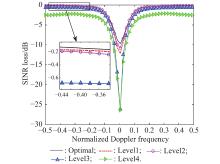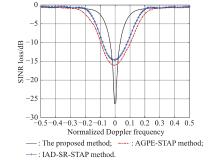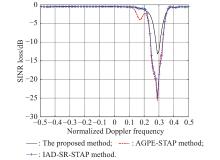| 1 |
WARD J. Space-time adaptive processing for airborne radar. ESC-TR-94-109. Lexington: Lincoln Laboratory, 1994.
|
| 2 |
KLEMM R. Principles of space-time adaptive processing. London: The Institution of Electrical Engineers, 2006.
|
| 3 |
BRENNA L E, REED I S Theory of adaptive radar. IEEE Trans. on Aerospace & Electronic System, 1973, 9 (2): 237- 252.
|
| 4 |
KLEMM R Adaptive airborne MTI: an auxiliary channel approach. IEEE Proceeding F: Communications, Radar and Signal Processing, 1987, 134 (3): 269- 276.
doi: 10.1049/ip-f-1.1987.0054
|
| 5 |
WANG Y X, LI X M, GAO W Dimension-reduced bi-iterative space-time adaptive processing method for airborne radar. The Journal of Engineering, 2019, 2019 (21): 8138- 8141.
doi: 10.1049/joe.2019.0718
|
| 6 |
WANG X, YANG Z, YANG J X Reduced-dimension space-time adaptive processing for airborne radar with co-prime array. The Journal of Engineering, 2019, 2019 (10): 5971- 5974.
|
| 7 |
HUA Y, NIKPOUR M, STOICA P Optimal reduced rank estimation and filtering. IEEE Trans. on Signal Processing, 2001, 49 (3): 457- 469.
doi: 10.1109/78.905856
|
| 8 |
SARKAR T K A deterministic least-squares approach to space-time adaptive processing (STAP). IEEE Trans. on Antennas Propagation, 2001, 49 (1): 91- 103.
doi: 10.1109/8.910535
|
| 9 |
MEVIN W L, SHOWMAN G A An approach to knowledge-aided covariance estimation. IEEE Trans. on Aerospace & Electronic System, 2006, 42 (3): 1021- 1042.
|
| 10 |
GUERCI J R, BARANOSKI E J Knowledge-aided adaptive radar at DARPA: an overview. IEEE Signal Processing Magazine, 2006, 23 (1): 41- 50.
doi: 10.1109/MSP.2006.1593336
|
| 11 |
STOICA P, LI J, ZHU X, et al On using a prior knowledge in space-time adaptive processing. IEEE Trans. on Signal Processing, 2008, 56 (6): 2598- 2602.
doi: 10.1109/TSP.2007.914347
|
| 12 |
YANG Z C, LI X, WANG H Q, et al On clutter sparsity analysis in space-time adaptive processing airborne radar. IEEE Geoscience and Remote Sensing Letters, 2013, 10 (5): 1214- 1218.
doi: 10.1109/LGRS.2012.2236639
|
| 13 |
SEN S Low-rank matrix decomposition and spatio-temporal sparse recovery for STAP radar. IEEE Journal of Selected Topics in Signal Processing, 2015, 9 (8): 1510- 1523.
doi: 10.1109/JSTSP.2015.2464187
|
| 14 |
YANG Z C, LI X, WANG H Q, et al Adaptive clutter suppression based on iterative adaptive approach for airborne radar. Signal Processing, 2013, 93 (12): 3567- 3577.
doi: 10.1016/j.sigpro.2013.03.033
|
| 15 |
WU Q S, ZHANG Y D, AMIN M G, et al Space-time adaptive processing and motion parameter estimation in multistatic passive radar using sparse Bayesian learning. IEEE Trans. on Geoscience Remote Sensing, 2016, 54 (2): 944- 957.
doi: 10.1109/TGRS.2015.2470518
|
| 16 |
SUN K, MENG H D, WANG Y L Direct data domain STAP using sparse representation of clutter spectrum. Signal Processing, 2001, 91 (9): 2222- 2236.
|
| 17 |
FENG W K, ZHANG Y, HE X Cascaded clutter and jamming suppression method using sparse representation. Electronics Letters, 2015, 51 (19): 1524- 1526.
doi: 10.1049/el.2015.1853
|
| 18 |
WANG X Y, YANG Z C, HUANG J J. Sparsity-based space-time adaptive processing for airborne radar with coprime array and coprime pulse repetition interval. Proc. of the IEEE International Conference on Acoustics, Speech and Signal Processing, 2018: 3310–3314.
|
| 19 |
DUAN K Q, WANG Z T, XIE W C Sparsity-based STAP algorithm with multiple measurement vectors via sparse Bayesian learning strategy for airborne radar. IET Signal Processing, 2017, 11 (5): 544- 553.
doi: 10.1049/iet-spr.2016.0183
|
| 20 |
WANG Z T, XIE W C, DUAN K Q Clutter suppression algorithm based on fast converging sparse Bayesian learning for airborne radar. Signal Processing, 2017, 130 (1): 159- 168.
doi: 10.1016/j.sigpro.2016.06.023
|
| 21 |
GUO Y D, LIAO G S, FENG W K Sparsity representation based algorithm for airborne radar in beam-space post-Doppler reduced-dimension space-time adaptive processing. IEEE Access, 2017, 5, 5896- 5903.
doi: 10.1109/ACCESS.2017.2689325
|
| 22 |
WANG X, YANG Z, HE K, et al. A low complexity space-time adaptive processing with sparse constraint based on conjugate gradient techniques. Proc. of the 14th IEEE International Conference on Signal Processing, 2018: 898–902.
|
| 23 |
CHAE D H, SADEGHI P, KENNEDY R A. Effects of basis-mismatch in compressive sampling of continuous sinusoidal signals. Proc. of the 2nd International Conference on Future Computer and Communication, 2010: 739–743.
|
| 24 |
FENG W K, GUO Y D, ZHANG Y S, et al. Airborne radar space time adaptive processing based on atomic norm minimization. Signal Processing, 2018, 148: 31–40.
|
| 25 |
GU Y, ZHANG Y D. Atomic decomposition-based sparse recovery for space-time adaptive processing. Proc. of the 52nd Asilomar Conference on Signals, Systems, and Computers, 2018: 1116–1120.
|
| 26 |
PAN J, TANG J, LI W, et al. Sparse clutter for STAP based on decouple atomic norm minimization. Proc. of the International Conference on Radar, 2018. DOI: 10.1109/RADAR.2018.8557229.
|
| 27 |
ZHU Y A, YANG Z C, HUANG J J. Sparsity-based space-time adaptive processing considering array gain/phase error. Proc. of the CIE International Conference on Radar, 2016. DOI: 10.1109/RADAR.2016.8059406.
|
| 28 |
MA Z Q, LIU Y M, MENG H D, et al Sparse recovery-based space-time adaptive processing with array error self-calibration. Electronics Letters, 2014, 50 (13): 952- 954.
doi: 10.1049/el.2014.0315
|
| 29 |
TANG G, BHASKAR B, SHAH P, et al Compressed sensing off the grid. IEEE Trans. on Information Theory, 2013, 59 (11): 7465- 7490.
doi: 10.1109/TIT.2013.2277451
|
| 30 |
CHI Y J, CHEN Y X Compressive two-dimensional harmonic retrieval via atomic norm minimization. IEEE Trans. on Signal Processing, 2015, 63 (4): 1030- 1042.
doi: 10.1109/TSP.2014.2386283
|
| 31 |
TITI G W, MARSHALL D F. The ARPA/NAVY mountaintop program: adaptive signal processing for airborne early warning radar. Proc. of the IEEE International Conference on Acoustic, Speech and Signal Processing, 1996: 1165–1168.
|
 ), Yongbo ZHAO*(
), Yongbo ZHAO*( ), Chenghu CAO(
), Chenghu CAO( ), Baoqing XU(
), Baoqing XU( ), Yili HU(
), Yili HU( )
)













